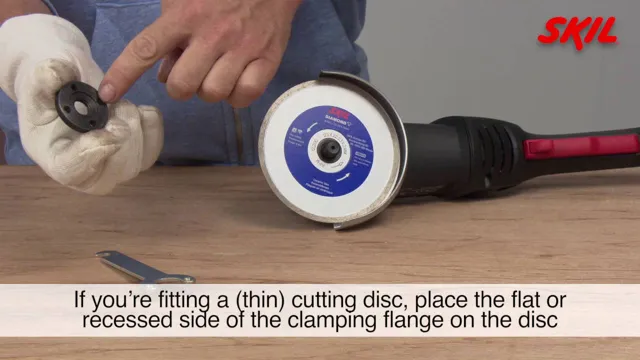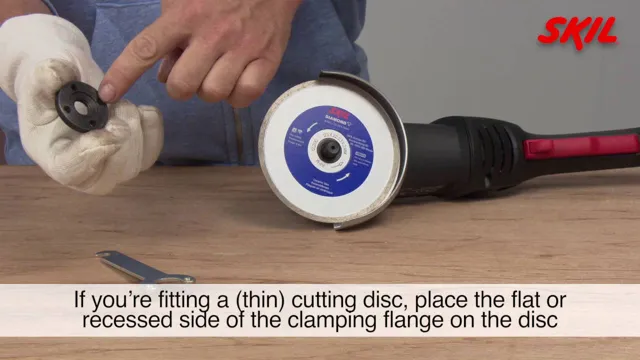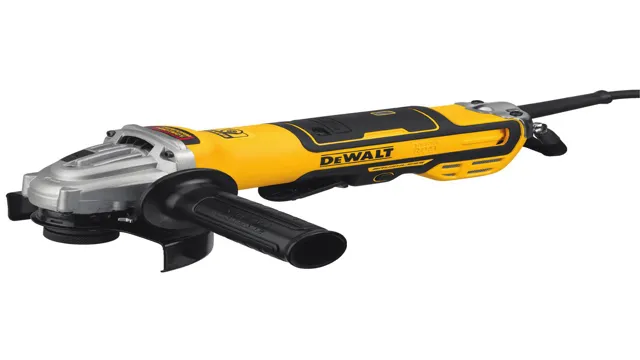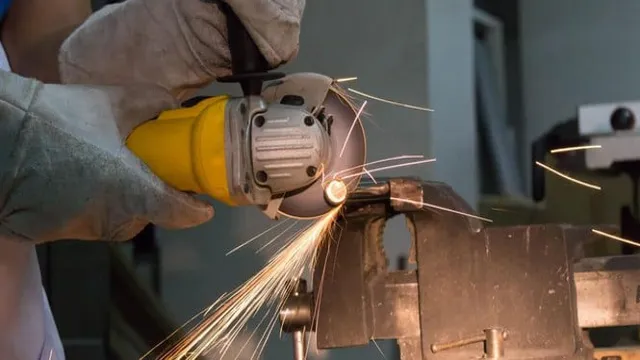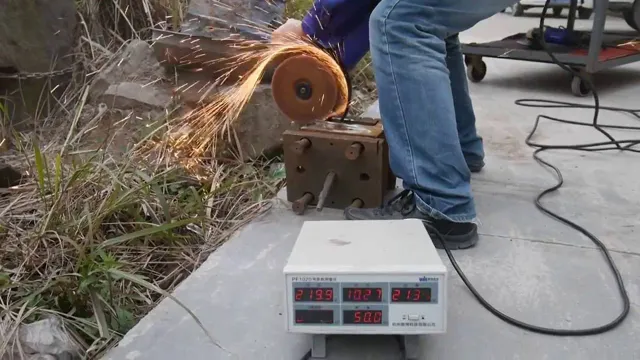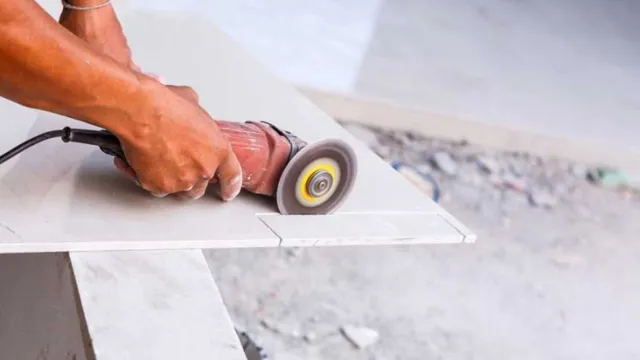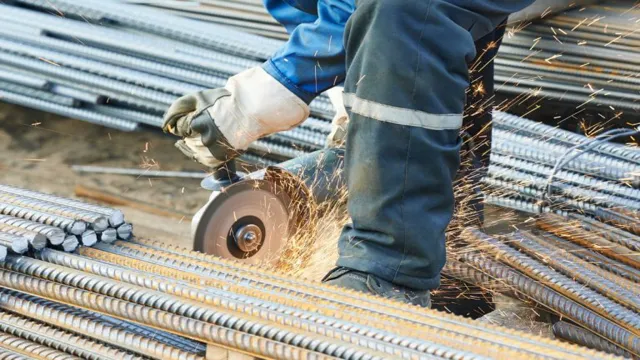How to Use Ryobi Angle Grinder- Tips and Techniques for the Best Results
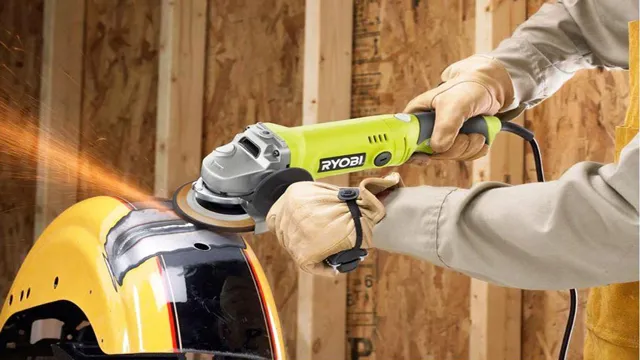
Are you new to using angle grinders? Looking for a reliable and user-friendly tool to get started? Look no further than the Ryobi angle grinder. Whether you’re an experienced DIYer or just starting out on your DIY journey, the Ryobi angle grinder is a versatile tool that can handle a range of cutting, sanding, and grinding tasks. In this comprehensive guide, we’ll walk you through everything you need to know to get the most out of your Ryobi angle grinder, from choosing the right accessories to using it safely and efficiently.
So, put on your safety glasses, grab your Ryobi angle grinder, and let’s get grinding!
Safety First: Precautions to Take Before Using a Ryobi Angle Grinder
Learning how to use a Ryobi angle grinder is an essential skill for anyone who wants to undertake DIY projects. However, before you begin grinding, it is essential to consider safety first. The most critical precaution to take before using a Ryobi angle grinder is to wear protective gear.
This includes safety glasses or goggles, face shields, gloves, and earplugs. The grinding wheel on a Ryobi angle grinder rotates at a high speed, which creates a lot of dust and debris that can cause serious harm to your eyes, ears, and skin. Additionally, it’s crucial to ensure that the grinding wheel is securely attached to the motor shaft and the guards are in place before you begin using the grinder.
Always take the time to read the manufacturer’s instructions and follow them closely to avoid accidents. Remember, using a Ryobi angle grinder can be safe and effective if you take the necessary precautions.
Read the Manual and Be Familiar with the Grinder
When it comes to using a Ryobi Angle Grinder, safety should be your top priority. Before you even pick up the tool, make sure you read the manual and become familiar with the grinder’s features and controls. This will help you avoid any potential accidents or injuries.
It’s also important to wear protective gear such as safety goggles, gloves, and a face mask. Check that the grinder is in good condition, with no cracks or damage, and that all the moving parts are well lubricated. Make sure that the power source you’re using is compatible with the tool and that you’re using the correct type of blades or discs.
Always grip the tool firmly, with both hands, and maintain a good balance while using it. Remember, an angle grinder is a powerful tool, and it can cause serious harm if not used correctly. So be sure to take all the necessary precautions before embarking on your grinding project.
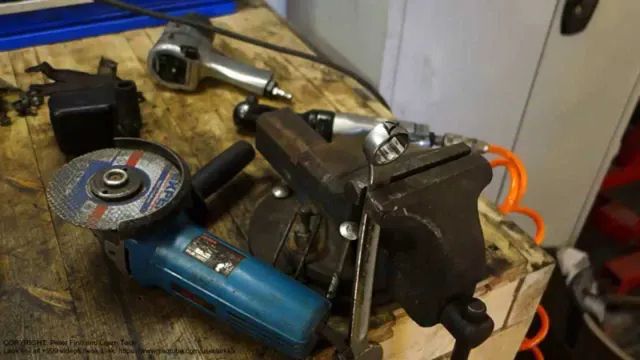
Wear Personal Protective Equipment
When it comes to using a Ryobi angle grinder, safety should always come first. One of the most important precautions to take is wearing personal protective equipment. This includes safety glasses or a face shield to protect your eyes from flying debris, as well as gloves to shield your hands from the sharp edges of the grinder disc.
Additionally, it’s critical to wear proper hearing protection, as angle grinders can produce loud noises that can cause permanent damage to your hearing. It’s also recommended to wear a dust mask, especially when working with materials that can produce harmful dust or fumes. By wearing the appropriate personal protective equipment, you’ll be able to use your Ryobi angle grinder safely and without fear of injury or harm.
Remember, safety first!
Inspect the Grinder and Disc Before Use
Before using a Ryobi angle grinder, it is essential to take necessary precautions to ensure your safety. One of the most critical things to consider is inspecting the grinder and disc before use. Check the disc for any chips, cracks, or signs of wear and tear.
If the disc is damaged, never use it as it could break during use and cause serious injury. It is also crucial to ensure that the disc is the correct type for the job you are about to undertake. Using the wrong disc can lead to serious accidents or injuries.
Next, check the grinder for any damage or defects in the parts. Never use a damaged or faulty grinder as it can lead to life-threatening accidents. Once you have checked everything and confirmed that the grinder and disc are in good working condition, you can proceed with using your Ryobi angle grinder.
Remember always to prioritize your safety when handling power tools.
Preparing the Grinder for Use
If you’re new to using an angle grinder, it can feel daunting to get started. But with the right preparation, using a Ryobi angle grinder is easy to do. First, make sure you have all the necessary safety gear, including goggles, gloves, and a face mask.
Next, secure the grinder’s disc by tightening the retaining nut with the wrench provided. It’s important to make sure the disc is properly aligned to avoid accidents. Once the disc is in place, plug in your grinder to a power source and make sure the switch is in the off position.
Hold the grinder securely with both hands and turn it on. Practice different techniques like moving the grinder back and forth or in a circular motion to get a feel for the tool. Remember to always keep a firm grip, and never use your grinder at an angle that could cause the disc to jam.
Incorporating these steps will ensure that you are able to effectively use your Ryobi angle grinder while ensuring your safety.
Choose the Right Disc for your Task
When it comes to using a grinder, the type of disc you choose can make all the difference. Before you begin your task, it’s essential to prepare the grinder and select the right disc for your needs. Ensuring the disc is correctly installed and securely fastened is crucial, as an improperly installed disc can be dangerous.
Additionally, selecting the correct disc type for your task will enhance performance and reduce wear and tear. For instance, a cutting disc is ideal for cutting metal, while a sanding disc is suited for smoothing out wood surfaces. By selecting the right disc, you’ll achieve optimal results with less effort and time.
Always remember to follow safety guidelines and take necessary precautions to ensure a safe and successful outcome.
Mount and Secure the Disc on the Grinder
One of the most important steps in using a grinder is to properly mount and secure the disc. Before doing so, make sure your grinder is unplugged and turned off. Then, choose the appropriate disc for the task at hand – for example, a grinding disc should be used for removing rust or excess material, while a cutting disc is better suited for slicing through metal or concrete.
Remove the disc guard and insert the disc onto the spindle, making sure it sits flush against the grinder. Use the wrench provided to tighten the nut, ensuring the disc is securely in place. Finally, replace the disc guard and lock it into position.
Keep in mind that failing to properly mount and secure the disc can pose serious safety risks, so take your time and double-check your work before using the grinder. With these simple steps, your grinder will be ready to tackle any task you throw its way.
Adjusting and Setting the Guard and Handle
Adjusting the guard and handle is a crucial step in preparing your grinder for use. In order to grind effectively, the guard should be properly adjusted to prevent any flying debris from hitting you. You should also adjust the handle to ensure that it provides you with the right level of control and comfort.
First, check the guard for any cracks or damage, and make sure it is properly secured to the grinder. Next, adjust the guard so that it is parallel to the grinding wheel and only a few millimeters away from the workpiece. Then, adjust the handle so that it allows you to maintain a comfortable and stable grip.
This will help prevent fatigue and ensure that you have complete control over the grinder. Remember, the safety of yourself and those around you is paramount when grinding. Taking the time to properly set up your grinder will pay dividends in the long run, as you will be able to work more efficiently and safely.
Using the Ryobi Angle Grinder
If you’re looking to tackle some DIY projects, the Ryobi angle grinder is a versatile and powerful tool that can help you get the job done quickly and efficiently. But before you start using it, there are a few things to keep in mind. First, make sure you have the right attachments for the task at hand.
The Ryobi angle grinder comes with a range of different discs that can be used for cutting, grinding, sanding, and polishing. You should also wear protective gear like safety goggles and gloves to protect yourself from sparks and debris. When using the angle grinder, make sure you have a steady hand and maintain a firm grip on the tool.
Remember to keep the blade moving steadily and apply even pressure to avoid any unwanted chipping or cracking. With a little practice and care, the Ryobi angle grinder can be an indispensable tool for any DIY enthusiast or professional alike.
Turn on the Grinder and Let it Reach Full Speed
When using the Ryobi Angle Grinder, it’s essential to turn on the grinder and let it reach full speed before starting your project. This ensures that the grinder’s motor is working efficiently and prevents any damage to the tool. As you turn on your grinder, listen for any strange noises, like grinding or clunking, which could indicate a mechanical issue.
Once the motor is running smoothly, you can begin your project with confidence. Keep in mind that using the Ryobi Angle Grinder can be dangerous, so always wear protective gear like gloves and eye goggles, and work in a well-ventilated area. With these precautions in mind, you can achieve a smooth and efficient grinding experience that produces excellent results.
So, why not give it a try and see how the Ryobi Angle Grinder can enhance your next project?
Position the Disc at the Correct Angle and Start Grinding
When using the Ryobi angle grinder, it’s crucial to position the disc at the correct angle before you start grinding. This ensures that you achieve the desired results and also prevents damage to the tool. To start, make sure that your work surface is stable and secure.
Then, attach the appropriate grinding disc to the grinder. Next, adjust the guard to ensure that it’s covering the top half of the disc and provides a safe distance between you and the workpiece. Hold the grinder firmly with both hands and place it perpendicular to the work surface.
Finally, rotate the grinder so that the disc is at the desired angle and start grinding. Remember to wear appropriate safety gear, including eye and ear protection, as the grinder can produce a lot of dust and noise. By following these steps, you can ensure that you achieve a professional finish while using the Ryobi angle grinder.
Keep a Firm Grip and Use Proper Body Positioning
When it comes to using the Ryobi Angle Grinder, it’s important to keep a firm grip and use proper body positioning. The key to safely using any power tool is to maintain control at all times. With the Ryobi Angle Grinder, it’s critical to use both hands to ensure a secure hold on the tool.
Keep your dominant hand on the handle, and use your other hand to guide the grinder. It’s also essential to use the right body positioning when using the grinder. Stand with your feet shoulder-width apart, and keep your knees slightly bent for stability.
Use your opposite foot to provide balance and support while grinding. With these techniques, you’ll maintain control of your Ryobi Angle Grinder and achieve safe, precise cuts every time.
Take Breaks and Let the Grinder Cool Down When Needed
If you’re using the Ryobi Angle Grinder, it’s important to take breaks and let the grinder cool down when needed. The Ryobi Angle Grinder is a powerful tool that can easily grind and cut through metal, concrete, and other tough materials. However, with great power comes great responsibility.
It’s important to use the grinder in short bursts and give it time to rest so it doesn’t overheat. Not only can overheating cause damage to the tool, but it can also be dangerous. Plus, taking breaks gives you a chance to rest and mentally recharge.
Remember, safety always comes first when using power tools. So, take the time to take breaks and let your Ryobi Angle Grinder cool down when needed. Your tool (and your body!) will thank you for it.
After Use and Maintenance
When it comes to using a Ryobi angle grinder, safety should always come first. Before starting, make sure to read the instruction manual and wear appropriate safety gear like eye protection, gloves, and a dust mask. Once you’ve got the hang of it, be mindful of the pressure you apply and keep both hands on the tool.
As for maintenance, keeping your angle grinder clean and well-oiled will ensure its longevity. Check the tool’s accessories regularly and replace any worn or damaged parts. Also, be sure to store it properly in a dry, clean area.
With proper use and maintenance, your Ryobi angle grinder will continue to be a reliable and efficient tool for all your grinding needs.
Switch Off the Grinder and Unplug it
After using your grinder, it’s important to switch it off and unplug it. This simple step can help ensure the safety of yourself and others who may come into contact with the machine. Leaving the grinder on or plugged in when it’s not in use can cause it to overheat or malfunction, which could result in serious injuries or damage to the machine.
Additionally, unplugging the grinder after use can help extend its lifespan and reduce the risk of electrical issues. So, always remember to switch off the grinder and unplug it when you’re finished using it. It’s a quick and easy step that can make a big difference in terms of safety and machine maintenance.
Clean and Inspect the Grinder and Disc
Cleaning and inspecting the grinder and disc after use is a crucial step towards maintaining its performance and extending its life. First, unplug the grinder from the power source and remove the disc carefully. Then, use a brush to remove any debris or dust that may have accumulated on the grinder and disc during use.
Next, inspect the disc for any signs of wear and tear, such as cracks or chips. If there are any visible damages, replace the disc immediately to prevent any potential safety hazards. Finally, wipe down the grinder and disc with a clean cloth to remove any remaining dirt or debris.
By taking these simple steps, you can ensure that your grinder remains in good condition and continues to provide efficient and effective results. Remember, regular maintenance is essential to keeping your tools in top shape, so don’t neglect this important part of the process!
Store the Grinder and Disc in a Safe Place
After using and maintaining your angle grinder, it’s crucial to store it and the disc in a safe place. Not only will this prevent any accidents or injuries from occurring, but it’ll also keep your tools in good shape for future use. When storing the grinder, make sure it’s in a dry, clean, and well-ventilated area.
Avoid storing it in a humid or damp area, as this can lead to rust and other damage. You should also keep the disc in a separate container or in the grinder’s case to prevent it from being damaged or lost. By taking the time to properly store your angle grinder and disc, you’ll ensure that they’ll be ready to use whenever you need them again.
So, don’t forget this important step after using your angle grinder, and you’ll be able to safely and efficiently complete your next DIY project!
Perform Regular Maintenance and Replace Discs When Necessary
When it comes to using and maintaining discs for your electronic devices, regular upkeep is key. After using a disc, make sure to store it properly in a clean and dry location, away from any potential damage. And, to ensure that your discs continue to perform at their best, regularly clean and inspect them.
This means wiping them down with a gentle cloth and checking for any scratches or signs of wear and tear. If you do notice any damage, it’s best to replace the disc rather than risk causing further problems down the line. By performing regular maintenance and replacing discs when necessary, you can extend the life of your electronic devices while also ensuring that they run smoothly and efficiently.
So, take the time to care for your discs and they’ll take care of you!
Conclusion
In conclusion, using a Ryobi angle grinder is a piece of cake! Simply attach the appropriate blade or disc for your intended task, make sure it’s securely fastened, and let the grinder do the heavy lifting. But remember, like any tool, safety is key. Wear appropriate protective gear, always follow the manufacturer’s instructions, and take breaks when needed.
Now go forth and grind like a pro!”
FAQs
What is the maximum RPM of the Ryobi angle grinder?
The maximum RPM of the Ryobi angle grinder is typically around 11,000.
Can I use a Ryobi angle grinder for cutting metal?
Yes, the Ryobi angle grinder is designed for cutting and grinding various materials, including metal.
How do I change the disc or wheel on my Ryobi angle grinder?
To change the disc or wheel on your Ryobi angle grinder, first, make sure the tool is not connected to a power source. Then, remove the lock nut and washer and replace the disc or wheel with a new one. Make sure to properly tighten the lock nut and washer before using the tool again.
Is it necessary to wear safety gear when using a Ryobi angle grinder?
Yes, it is highly recommended to wear safety gear, including eye protection, gloves, and a dust mask when using a Ryobi angle grinder to protect yourself from sparks, debris, and dust.
Can I use a Ryobi angle grinder for sanding?
Yes, you can use a Ryobi angle grinder with sanding attachments to sand surfaces. However, it is important to make sure the attachment you are using is the correct one for the material you are sanding.
How do I adjust the guard on my Ryobi angle grinder?
To adjust the guard on your Ryobi angle grinder, loosen the screws that hold the guard in place and move it to the desired position. Then, tighten the screws to secure the guard in place.
How do I maintain my Ryobi angle grinder?
To maintain your Ryobi angle grinder, regularly clean the tool after use and make sure to inspect the disc or wheel for any cracks or damage before using it again. Additionally, check the tool’s brushes and replace them when they become worn.

